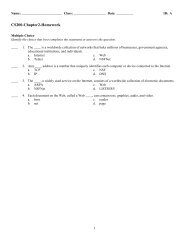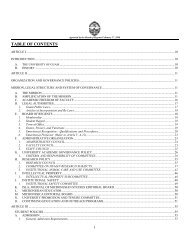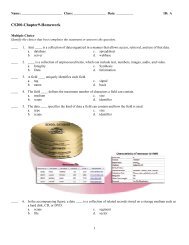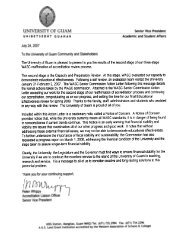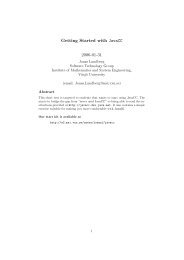Guam Business Resource Guide
Guam Business Resource Guide
Guam Business Resource Guide
You also want an ePaper? Increase the reach of your titles
YUMPU automatically turns print PDFs into web optimized ePapers that Google loves.
3.3.4.3 Quality Control<br />
How will consistent quality of product and service<br />
delivery be assured? What specific quality control<br />
measures will be implemented?<br />
3.3.4.4 Facilities<br />
Describe the physical facilities in which the business<br />
will be located. Is it owned or leased? What<br />
are the terms (price and duration) of the lease?<br />
What is the square footage and age of the building?<br />
Is there enough space to accommodate growth? Can<br />
the facilities be upgraded or will the business have<br />
to move if it grows during the planning period? Are<br />
the mechanicals (electric, plumbing, sewer, telecommunications)<br />
up to code and adequate for intended<br />
usage? Is there adequate parking and street<br />
access?<br />
3.3.4.5 Billing and Collection Procedures<br />
Describe the business credit plan and explain why<br />
this plan was chosen. How is credit worthiness determined?<br />
Describe billing procedures. Are accounts<br />
receivable monitored? How often? When is a<br />
receivable considered delinquent? Outline the steps<br />
followed from the time an account becomes delinquent<br />
until the delinquency is resolved. Are formal<br />
collection policies in place? Describe collection procedures.<br />
Who is responsible for billing receivables<br />
and for collections?<br />
3.3.4.6 Recordkeeping Policies and Procedures<br />
<strong>Business</strong> owners are responsible for maintaining a<br />
universally accepted method of recordkeeping. The<br />
system should be simple to use, accurate, timely,<br />
and consistent. It provides business management<br />
information for the owner but must also be designed<br />
for understanding by others with an interest<br />
in the business -- business consultants, lenders or<br />
government entities, for example.<br />
What recordkeeping tools or systems are in place?<br />
Identify the types of records kept. Who is responsible<br />
for recordkeeping? What is this person's background<br />
or experience with recordkeeping? Does the<br />
business use professional recordkeeping outside<br />
services? If so, from whom and what aspects of<br />
business recordkeeping do they perform? Describe<br />
daily, weekly or monthly recordkeeping routines.<br />
Identify financial reports used to measure and<br />
monitor the business condition. How often are<br />
these reports prepared?<br />
3.3.5 The Financial Plan<br />
The financial section of the business plan is the numerical<br />
expression of the marketing analysis and<br />
operating plans. The financial projections indicate<br />
if the business idea is attractive enough to secure<br />
investments and financing. The thoroughness of the<br />
financial plan will indicate to the reader that the<br />
business will be well managed. According to the<br />
SBA, "businesses do not fail for the lack of money<br />
as of cash as much as for the lack of money management."<br />
Entrepreneurs need sound records and<br />
financial management to keep track of assets and<br />
liabilities. And, they must always know the company's<br />
current and future cash positions.<br />
The cash flow projections and analysis are the most<br />
important section of the business plan. The need<br />
for cash flow planning comes from the time discrepancy<br />
that usually exists between the expenditure<br />
of funds for inventory, payroll, rent, debt payments<br />
and other overhead and the actual receipt of<br />
cash from sales. “Profits are great, but cash pays<br />
the bills.” Cash flow planning is simple in concept,<br />
but involved considerable effort to develop. Time<br />
is the critical ingredient in cash flow planning. The<br />
company may have considerable money coming in<br />
the future, but it could become insolvent if cash is<br />
paid out in the present. At any time, a negative<br />
cash balance must be covered either with equity or<br />
debt.’<br />
3.3.5.1 Historical Financial Statements<br />
For existing businesses, attach the past three years<br />
of Balance Sheets, Income Statements and Cash<br />
Flow Statements to the business plan. In this section<br />
discuss any relevant trends and variances in:<br />
assets, debts and equity; revenues, cost of goods<br />
sold (COGS), overhead and net income; cash received,<br />
cash paid out and net cash balances. Financiers<br />
will spread and analyze these statements and<br />
use the as a basis for evaluating the cash flow projections,<br />
break-even analysis and pricing and margins.<br />
If there are large unexplained differences between<br />
the past and the future, the projections will be discounted<br />
and the loan request may be denied or the<br />
loan amount reduced.<br />
11


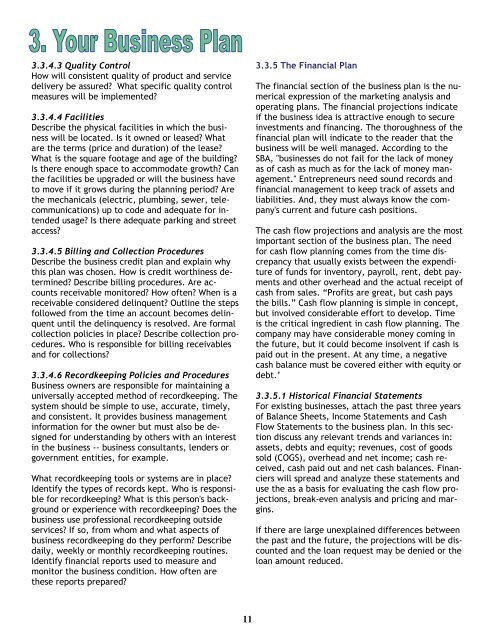


![Residence Hall Application Form [PDF]](https://img.yumpu.com/46340085/1/190x245/residence-hall-application-form-pdf.jpg?quality=85)
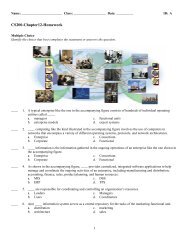

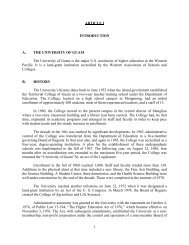
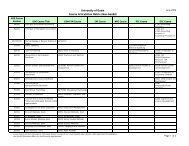
![Modern compiler design [PDF]](https://img.yumpu.com/37285279/1/190x245/modern-compiler-design-pdf.jpg?quality=85)
